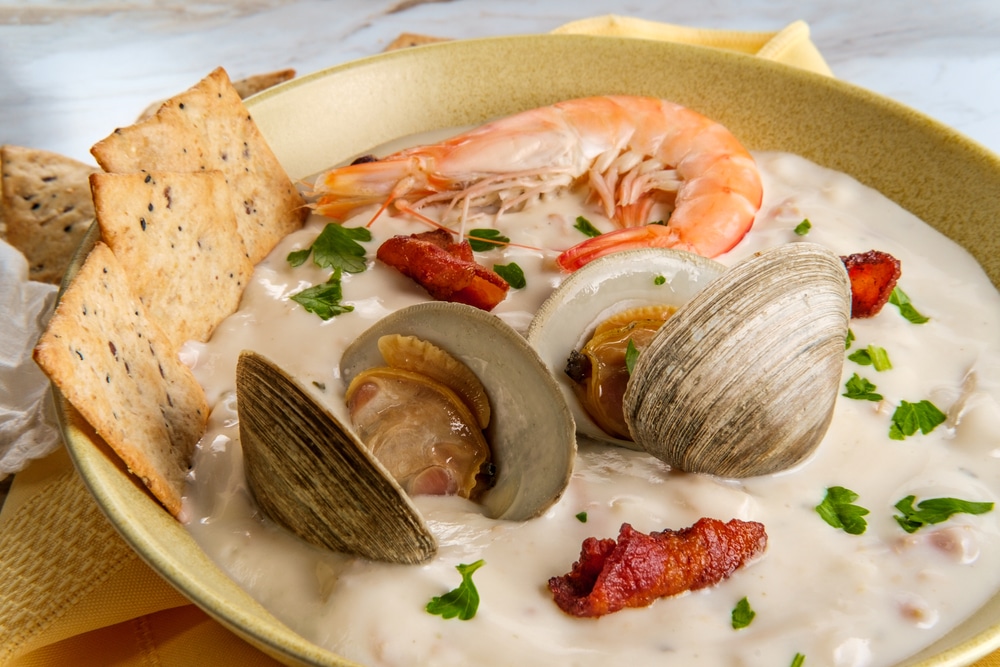
Clam base can be defined as the bouillon paste that’s used in chowders and seafood soups. The majority of recipes call for clam juice or clam broth; clam base is preferred by professional and experienced chefs as it takes away the blandness and adds a pronounced flavor. It is easily available in jars and is perfect for people who like to make seafood. However, if you cannot get your hands on the base, we have various clam base substitutes to help you out!
Clam Base Substitutes
- Fish Stock
Fish stock is the best alternative for clam base as it adds seafood flavor to the recipe without overpowering the flavor. This is readymade fish stock available in the grocery stores, but the bouillon cubes are also available, which can be resolved in water to achieve a thin consistency. In fact, you can also make your own fish stock by adding fish scraps and heads into the stockpot, along with celery, bell peppers, onions, and carrots. All these ingredients have to be simmered for half an hour and boiled in water to achieve liquid consistency. However, if you have a fish allergy, you should avoid using it.
- Chicken Stock
In case you cannot use fish stock because of allergies, you can always opt for chicken stock. It’s needless to say that the flavor won’t be the same, but you can add it to salmon chowder, sauces, and bisques to replace the clam base. In addition, it’s better that you dilute the stock to make sure it doesn’t have an intense chicken flavor. For instance, if your recipe called for one cup of clam base, you should add ½ cup of chicken stock. In fact, if you want to reduce your salt intake, you can opt for a low-sodium version.
- Vegetable Stock
If you are on a meat-free diet, there is no better option than vegetable stock. Vegetable stock is available in the premade form in the grocery stores. On the other hand, if you want to make your own vegetable stock, you need to simmer and boil Portobello mushrooms, celery, onions, carrots, and dry white wine, along with the seasoning – this mixture should be cooked for an hour or two to achieve rich flavor. In addition, it’s recommended that you strain the stock before you add it to the sauces and stews, but it won’t go well with seafood recipes.
- Dashi
To illustrate, this is the Japanese stock that incorporates intense umami flavor into the food. Dashi is a great poaching liquid for seafood, and you can use it as a base for miso soup. In addition, you can use dashi to make the noodle broth soup – many people mix dashi with flour to coat the food before you grill it. It’s quite easy to make dashi at home, but it’s quite easy to find dashi powder in supermarkets, particularly the Asian stores.
- Oyster Liquor
Oyster liquor is basically natural juice that’s taken from raw oysters. It is known to keep the fresh oysters alive once they are taken out of the water. Once the oysters are used, the remaining liquid is used as an alternative for clam base. It can be added to pasta alle vongole and miso soup. In addition, oyster liquor can be used in risotto or paella. However, it has a higher salt content, which is why you should add 50% less oyster liquor. Also, you can always do a taste test to add the oyster liquor that complements the dish’s flavor.
- Clam Juice
Clam juice is another great option if you want to replace the clam base in the recipe. While clam juice is available at grocery stores, it’s better that you make your own clam juice for a more authentic flavor. To make the clam juice, you need to stream around two pounds of clams with an inch of water in the pan (stir the pot occasionally). As a result, the clams will release the juice, and the clam juice will be ready.
- Dry White Wine
This is an unconventional alternative and is great for people who cannot find any other substitutes mentioned in the article. It can be used to replace clam base in soups, chowders, and pasta. That’s because it promises a similar flavor to the food and has the same consistency.